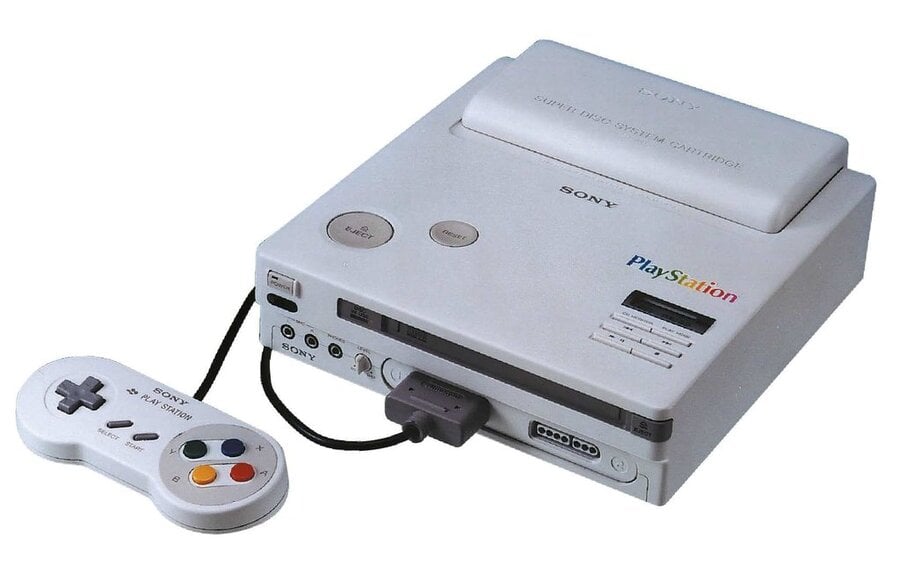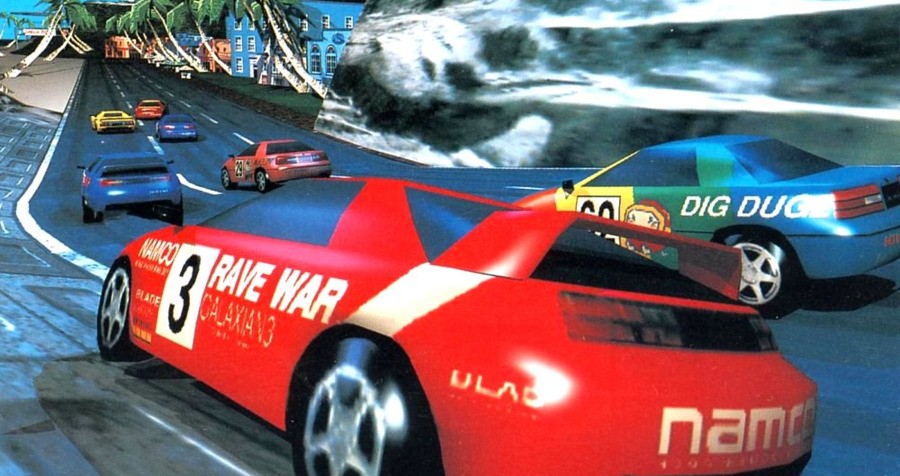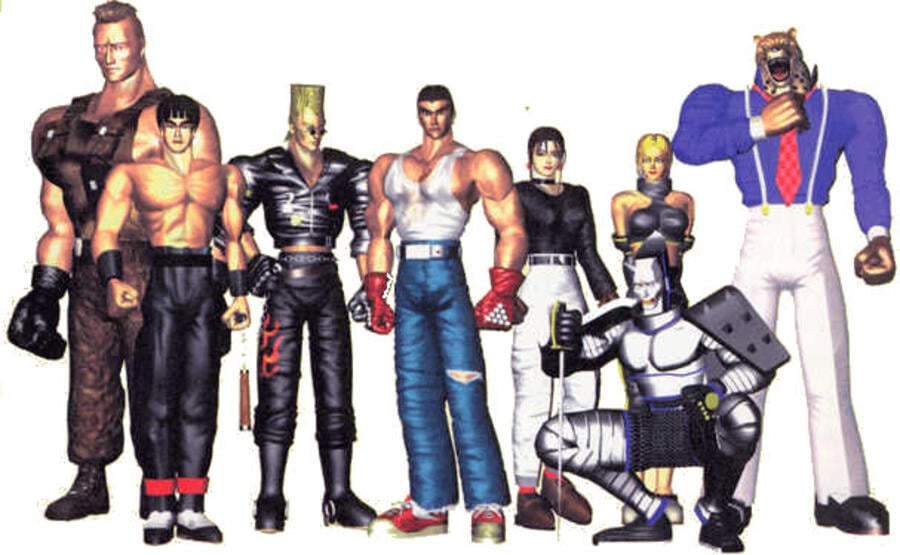
Hell hath no fury like a Japanese tech giant scorned – as the saying doesn't go – but when Nintendo left Sony at the altar following a passionate yet brief engagement which almost saw the two joining forces to create an all-in-one SNES CD-ROM system, few would have believed that in the space of just a few years the jilted party would be the biggest name in the video game arena. PlayStation might be a household name now, but twenty years ago – when the console made its debut in its native Japan – it was very much an unknown quantity.
Having been contracted by Nintendo to produce the superb SPC-700 sound processor for its SNES console, the next logical step was to forge some kind of mutually beneficial alliance with the Kyoto veteran
Of course, the story of the PlayStation began many years before the iconic grey box appeared on Japanese store shelves on December 3rd, 1994. As a massive corporation which likes making money, Sony had never made any secret of its desire to gain a foothold in the growing electronic entertainment industry – it was part of the MSX home computer project during the '80s, and also created a new CD standard capable of storing data as well as audio – dubbed CD-ROM/AX – with Dutch firm Philips. Neither venture turned out quite as expected, and as the CD arms race ensued and various non-gaming companies cranked out their own "interactive" disc-based hardware, Sony became increasingly keen to throw its hat into the ring. Having been contracted by Nintendo to produce the superb SPC-700 sound processor for its SNES console, the next logical step was to forge some kind of mutually beneficial alliance with the Kyoto veteran – and that is exactly what occurred.
Headed by Ken Kutaragi – the same man who produced the aforementioned SPC-700 chip – the CD-ROM-based SNES "Play Station" was set to be a quite audacious move by Sony, which had thus far struggled to make any impression on the video game market via its publishing arm, Sony Imagesoft. A fusion of Sony's CD know-how and Nintendo's best-selling games console, this system would accept all existing SNES carts but would also play enhanced disc-based software, the licensing for which would be retained by Sony itself rather than Nintendo. Prototype designs were shown off in the press and the project appeared to be progressing well, but things were less than rosy behind the scenes. Nintendo was unhappy with the terms of the proposed agreement, which would allow Sony to take a fee for every game retailed. In short, the deal was better for Sony than it was for its esteemed partner, and should the Play Station become a success, Nintendo would have effectively created another rival in the video game arena. After witnessing its reign of utter dominance come to an end thanks to the efforts of startup SEGA during the early '90s, the prospect of additional competition was clearly not something that the late Nintendo president Hiroshi Yamauchi was willing to entertain; he decided to break up the nascent arrangement in the most public way imaginable.

Sony arrived at the 1991 Consumer Electronics Show full of swagger and confidence, and rightly so – it was about to officially announce its union with the biggest name in video games and show off the proposed SNES Play Station system which would make it a major player in the entertainment sector almost overnight. The press conference generated a remarkable level of excitement, but the positive feeling was short-lived. Shortly afterwards during its own presser, Nintendo double-crossed its proposed ally and stated that it was now working with Philips on a SNES CD-ROM drive. It was a cruel and bitter blow, and a very public embarrassment for the Japanese firm. True, Sony had perhaps been a little naive in thinking that Nintendo would allow it to simply waltz in and profit from the existing success of the SNES thanks to its proposed licensing arrangement, but even so, this was a move clearly designed to humble. Nintendo was sending a clear message to Sony's bosses, and Kutaragi: This is our turf, you don't belong here.
Nintendo was sending a clear message to Sony's bosses, and Kutaragi: This is our turf, you don't belong here
Incredibly, talks between the two firms didn't entirely break down at this point. Nintendo's move was legally questionable and had Sony wanted to, it could have easily taken the video game giant to court. However, Sony still saw Nintendo as a valuable trading partner – its sound chip was in the SNES, after all – and legal action never materialized. In fact, Nintendo and Sony went on to sign another agreement which would allow the now SNES-less Play Station console to be made compatible with Nintendo's new CD standard – a standard which would of course fail to materialise as it became increasingly clear that the CD revolution was something of a false dawn, at least as far as 16-bit consoles were concerned. Nintendo would famously back out of its arrangement with Philips as well, softening the blow by allowing the Dutch firm to produce a smattering of generally terrible Nintendo-related games on its ailing CD-i system. This dilly-dallying delayed Sony's efforts further, and by 1992 the company decided to totally sever its ties with Nintendo.
During a crunch meeting with Sony president Norio Ohga, Kutaragi dropped a bombshell which very nearly ended the PlayStation project there and then. He insisted that the notion of building a console around the SNES was doomed to failure, despite the popularity of Nintendo's console. The only way forward for Sony was to produce its own hardware, capable of shifting complex 3D visuals similar to those appearing in arcade titles like SEGA's Virtua Racing. The PlayStation had already cost Sony a substantial amount of cash in R&D, and had thus far generated no revenue for the firm. But – as we said in the intro – hell hath no fury. Ohga was not prepared to take such a high-profile snub lying down, and although Kutaragi's plan was risky and would cost a lot of money, the desire for revenge was so great that the Sony president put aside the concerns of the company's other executives – who vehemently opposed the idea – and gave the green-light.

The next two years would be incredibly busy for Kutaragi and his team. Early in '94, Sony revealed the PlayStation-X – the stubborn decision to retain the name being the business equivalent of a raised middle finger to Nintendo – and began courting developers. Sony Imagesoft's generally lamentable efforts aside, the company had no real experience in creating games itself, but it was at least aware of this fact – and of how much of an advantage Nintendo and SEGA's internal development studios gave them. To attract third-parties to the new system, Sony devised a ground-breaking licensing arrangement which must have felt like a breath of fresh air following SEGA and Nintendo's extortionate agreements, which saw publishers having to pay massive sums to the platform holders to produce cartridges on their behalf. CDs were cheap to produce and if your game wasn't a success, it didn't mean you were left with an expensive amount of unsold stock.
If a giant company like Panasonic couldn't do it, why was Sony any different?
However, Sony knew that this alone wouldn't be enough to gain the vital support of developers and publishers – especially as SEGA's rival Saturn console also offered the benefit of using low-cost CDs. The company also had to counter the funk which had descended on the industry after so many failed attempts to crack the potential of CD-ROM; SEGA (Mega CD), Panasonic (3DO), NEC (PC Engine CD), and Fujitsu (FM Towns Marty) had all tried to create consoles based on the tech with very little commercial success. Set against this backdrop, it's easy to understand why the industry at large – as well as dubious consumers, already burned by past failures – was so sceptical that a newcomer like Sony could triumph where so many others had stumbled. If a giant company like Panasonic couldn't do it, why was Sony any different?
To counter this, Sony took significant action. Using its experience from distributing electronics and music, Sony established a massive sales force in Japan in order to assist with promoting the console and its games, and the effect was dramatic. The combination of the system's obvious power with the fact that Sony was bending over backwards to accommodate third-parties resulted in a stampede of software support in Japan. When the company unveiled the system and showed off its technical power with 3D demos which included the now-legendary T-Rex animation, it apparently caused SEGA of Japan president Hayao Nakayama to insist that his hardware division hastily bolster the power of the Saturn, a last-minute move which would make SEGA's console a frustrating beast to develop for. "If it's not real-time, it's not a game," boasted Sony Computer Entertainment's Akira Sato, a broadside clearly aimed at the hordes of FMV-based titles that typified CD-ROM gaming by this point. It was a clear message to the entire industry – the PlayStation was the real deal.

The graphical muscle of the PlayStation was also instrumental in attracting Namco's support, and the firm's conversion of its popular Ridge Racer coin-op would prove to be the console's killer app. Ported in just six months, this arcade smash-hit proved emphatically that Sony's offering was the most powerful 32-bit platform, making SEGA's in-house conversion of its ]Daytona USA property look decidedly rough in comparison.
As the Japanese launches of both the PlayStation and Sega Saturn approached, software became vitally important when it came to winning support from buyers. While Sony ultimately proved the victor in the 32-bit war, it's important to remember that in the early days it was a close-run thing. SEGA was still seen as the company to beat, especially in Japan where its arcade titles gave it a vital edge over the competition. One-on-one 3D brawler Virtua Fighter – which launched alongside the console – was the nation's most popular coin-op and sold at an almost 1:1 ration with the system. The PlayStation had Ridge Racer – undoubtedly its most notable launch title – as well other titles such as King's Field, the spiritual predeccessor to the Demon's and Dark Souls series. It was clear that the two rival systems were being sold on the accuracy of their arcade conversions, and despite Virtua Fighter's undeniable commercial clout, it was painfully obvious that Ridge Racer was the more technically impressive offering.
Despite Virtua Fighter's undeniable commercial clout, it was painfully obvious that Ridge Racer was the more technically impressive offering
Nonetheless, SEGA shifted an impressive 200,000 consoles on the Saturn's first day of sale, a robust and commendable achievement. Sony's launch just days later was equally successful, with the 100,000 consoles sent to retailers all selling out within a week – but in those early days, SEGA appeared to have the edge. In its first month on sale the PlayStation sold 300,000 units while the Saturn was reported to have achieved a 100,000 console advantage in the same time-scale – although it is believed that SEGA was being a bit cheeky by quoting units sent to retailers and not units actually in the hands of consumers.
Even so, this delicate balance of power would change rapidly as Sony's willingness to embrace third parties gave its system a wider and more varied range of software, while SEGA's steadfast reliance on its in-house teams arguably held the Saturn back. On Saturn key first-party titles were delayed and this impacted the long-term fortunes of the console, but Sony's flood of external support meant that PlayStation owners had plenty of games to keep them busy – including Namco's sublime Virtua Fighter rival, Tekken. By bringing so many Japanese developers on-side prior to launch, Sony had ensured a steady stream of software for its fledgling console that would carry it through into the new year.

The year after the PlayStation hit Japan it would launch to even greater success in North America and Europe, two territories where rival SEGA would have a much harder time convincing players that its Saturn was a viable choice. Nintendo would take a little longer to bring its N64 to market, and when it did so, it wasn't capable of catching up with Sony's dominant machine. Key allies such as Konami, Capcom, and Square all pledged their allegiance to the PlayStation, signalling the end of Nintendo's iron grip on the hearts and minds of the video game industry. Its moment of underhanded duplicity had created a fierce and dedicated rival, but Sony fans should perhaps be thankfully that Nintendo decided to cancel its agreement at the turn of the decade; without that burning desire for retribution, Sony may never have created the PlayStation.





Comments 17
That was a brilliant read.
Fantastic
Excellent read. Every time I read a story about what happened with all this, I always learn something new. All glory to Playstation!
on the flip side if Sony and Nintendo never split then the PS4 could have been the latest Nintendo console
Nintendo to Playstation: "PlayStation, I'm your Father" XD
Ok, Sorry, but yes, 20 years ago that a great console appear and well, almost all know it story, the great games that appear there and many interesting things that arrived too.
If well, even if it is thought that Nintendo and Sony still had continued together, possibly the story would be so different (including the existence of many franchises), well, that's pretty obvious, XD
But thanks to that "fear and disgust" from Nintendo about the contract with Sony, appears this great console that improves more to this game industry.
Wow. Great read. I never actually knew that there was a all-in-one PlayStation that could play SNES games. Cool concept, but I'm happy with how things turned out.
This was really interesting! Nice one, Damo
Thank you Damien.
Happy 20th anniversary Sony PlayStation.
I feel a slight sense of melancholy that Sony and Nintendo had so much bad energy towards each other, they were giant rivals of course, but they could have been not only great rivals but also great allies, who would have seen each other as respectable rivals, and not basically have too much fierce rivalry, both could have worked exceptionally well together (i believe). I personally work better alone, perhaps as you said Sony needed that burning desire the burning ambition to create our Sony PlayStation.
Happy 20th Anniversary PS1, may you live on forever in the hearts of gamers and nostalgia nuts everywhere!
@Damo: Great read. Its interesting how Nintendo's greed created its own rival.
Yea I have been telling some of my younger video game playing friends this story for years & they were shocked. It's so hilarious that Nintendo, basically, created the PlayStation. Karma is a bi*€&, right?
It's also the single biggest blunder by any video game company in the history of the industry. Even worse than Virtual Boy or Sega ruining their company with the Sega CD, 32X, & the horrendous decision to launch the Saturn WAY early, at E3, with no warning to their development teams.
Great article.
While there are many types of fanboy, all must respect that PlayStation truly changed gaming.. I love my Xbox, I have had great moments with Nintendo but PlayStation has paved the way and made gaming a fantastic experience. Nintendo always brought fun factor, Xbox brought a great online experience, Sony brought true gaming in every form. (My opinion:) I have many fond gaming memories (ALOT ON SEGA) PS1 will always be what I look back on and say that's when I became a true gamer.
@Tasuki
To be fair, it's not exactly like Nintendo was making out great on this deal, should've gone about getting out of the deal much differently than taking the scumbag route though.
@Damo, great read and some interesting stuff I didn't know about or had forgotten.
of course i realise this is a playStation site , but out of all the consoles that have come and gone , the one i wiished to have suceeded over everything would be the 3DO (...if only)
Happy 20th anniversary PlayStation .
@damo About my 3rd time reading this, thanks for the trip down memory lane! Loving the pushsquare history lessons leading up to the playstation experience.
#gameon
now Sony, please have prepared a trailer for a remastered version of final fantasy VII, thanks!
I was always a die hard Nintendo fan, and pretty much turned my nose up at the PS1 when it launched. No way that some newcomer could match Nintendo. I waited on pins and needles for the N64 and when it launched, it was the biggest let down in (my) gaming history. Game selection was terrible, the controller was awkward, and the games on the PS1 just looked better (not to mention all my favorite developers, like squaresoft, we're missing). It was with a heavy heart that I switch to Playstation and I have never looked back.
We'll that's not entirely true, years later I bought an N64 for Mario 64 and Mario Kart, because no one has made a 3D platformer that is as awesome as Mario, and CTR couldn't hold a candle to MK.
Leave A Comment
Hold on there, you need to login to post a comment...